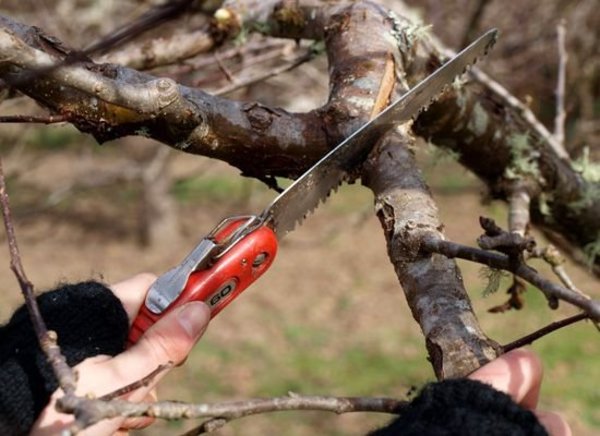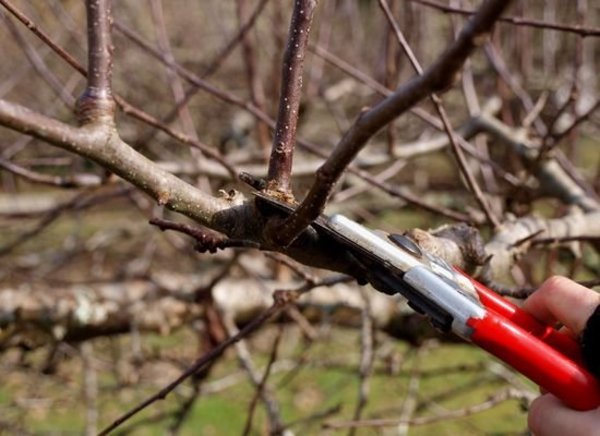A Beginner’s Guide to Pruning Fruit Trees

So you have that fruit tree in your backyard that produces a few nice pieces of fruit every year, but not quite enough for cannable batches of sauce or fun fruit recipes. You would love to harvest more of a bounty from your fruit tree, but have lots of strangely shaped or scabby pieces of fruit, and frankly, don’t want to climb into that jungle of limbs. So how do you up the production of the tree, turn it into a masterpiece of white blossoms in the Spring, and increase the longevity of the tree? Learn how to prune it, as right now is prime time to do it!

The main point of pruning is to keep the limbs of the tree open and exposed to sunlight and air. More sunlight on limbs, and ample breathing space between limbs will produce more fruit and a healthier, happier tree. Therefore, an overall rounded and oval shaped tree is best, as this allows sunlight on the lower limbs and the crown of the tree. Fruit trees are still dormant at this time of year, so pruning them will not disturb their bud development but rather pre-direct their growth for the coming season. It is always best to prune after risk of hard frosts, but before buds begin to develop blossoms. Trees are living creatures, so treat them with respect and give your pruning as much consideration and time as you would when taking care of any loved one.

Good tools are the key to effective pruning! You will need a clean, sharp pair of pruning clippers; Felco and Fiskars make some of the highest quality ones. A pair of loppers are best for pruning larger limbs, and a small pruning saw will help you get rid of very large limbs without tearing or yanking at the tree. A ladder will also be necessary if your tree is taller than you. Climbing into the tree is great for pruning the inside and crown of the tree, but a ladder will most likely be necessary for the outer perimeter of the top layer. Fruit picking ladders, available in 10, 20 and even 30 foot versions are fantastic, as they have a pivoting third leg that can be placed in between the limbs of the tree for better and more stable access to the tree. Check with your local hardware store or orchard to see if you can rent a fruit ladder for a weekend.

Limbs that are growing directly upward, at the base of the tree or from the main trunk of the tree are called suckers, because the suck energy from the tree. The first step in pruning is to remove all suckers, after which any limbs growing back in toward the trunk of the tree should be removed. Fruit cannot grow on a sucker, and fruit growing on limbs that are facing the trunk will not receive much sunlight. However, leaving a few vertical limbs on the crown of younger trees is a good way to encourage growth and they can even be bent and tied down to create arching limbs that can bear fruit.

After the suckers and inward growing limbs have been removed, you will begin to see the natural shape of the tree, also seeing more clearly where limbs are crowded and crossing over each other. These areas should be cleared so that limbs that are growing too far down from a higher branch or limbs that have woven their way through from a larger limb that is growing in a different direction should be removed. Very low limbs can also be removed, as you don’t want fruit growing close to the ground.
Then you will be able to shape the perimeter of the tree by cutting back the outermost limbs, which typically grow horizontally and then curve upwards. These limbs should be cut back to a downward facing bud, right at the point where the branch begins to curve upward. This will encourage the branch to grow out, rather than straight up. The more that you can branch a tree to grow out rather than up, the less suckers you will eventually have, eventually turning pruning into a small task as the tree will begin to shape itself optimally.

Making a cut in the right place is key. Make sure your tools are clean and sharp, so that you don’t crush or tear the limbs or trunk when making cuts. This allows the wood to heal faster and helps prevent bugs or bacteria from entering the tree. When pruning suckers, take your cut all the way down to the wrinkled place on the limb the sucker is growing from, which is called the healing wood. When pruning perimeter limbs or airing grown in sections, make your cuts within a ¼ inch of the bud, as the bud will direct the new growth of the limb.

Different types of fruit trees behave differently and require different amounts of pruning. However, the general rule with apples, pears, plums, cherries, persimmons, peaches, apricots and plumcots is to remove 20 percent of the previous year’s growth. If your tree has not been pruned in several years, a more vigorous trim may be necessary. Figs generally do not require pruning, as they shape themselves fairly openly and don’t tend to produce suckers. Citrus fruit generally only needs to be cleared around the bottom skirt of the tree by removing any limbs that are growing down and preventing air circulation to the bottom trunk of the tree.
By following the guidelines above, your tree(s) should begin to produce more fruit. If you have to prune the tree very vigorously, it may result in less fruit this season, as the tree is adjusting to your commands. You will also likely see an explosion of sucker growth the following season as the tree responds to initial shock. However, if you continue to prune and train the tree for optimal sunlight and air circulation, you will begin to see results!

Remember, pruning is an art that does take time to master, but you have to start somewhere. A tree that has turned into a jumbled mess of limbs can seem daunting, but go slow at first, and don’t make big cuts if you are not sure. Clear all the suckers and inward growth first, and stand back to look at the whole tree every now and then so that you can see how you are shaping it. Investing in a book on pruning is a fantastic idea for gaining a deeper understanding of caring for your fruit trees and other fruiting plants. Most of all, enjoy the connection you’re making to the tree and let your face smile at the early Spring sunshine!
Images: David Christian

